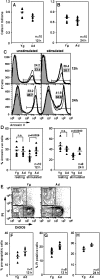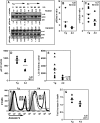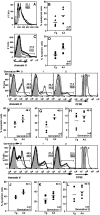Naive CD4 T cells from aged mice show enhanced death upon primary activation
- PMID: 19748905
- PMCID: PMC2767129
- DOI: 10.1093/intimm/dxp094
Naive CD4 T cells from aged mice show enhanced death upon primary activation
Abstract
Poor T cell immunity is one of the many defects seen in elderly humans and aged (Ad) mice. We report that naive CD4 T cells from aged mice (ANCD4 cells) showed greater apoptosis upon primary activation than those from young (Yg) mice, with loss of mitochondrial membrane potential, poor activation of Rel family transcription factors and increased DNA damage. Their ability to enhance glycolysis, produce lactate and induce autophagy following activation was also compromised. ANCD4 cells remained susceptible to death beyond first cell division. Activated ANCD4 cells also showed poor transition to a 'central memory' (CM) CD44(high), CD62L(high) phenotype in vitro. This correlated with low proportions of CM cells in Ad mice in vivo. Functionally, too, IFN-gamma responses recalled from T cells of immunized Ad mice, poor to begin with, worsened with time as compared with Yg mice. Thus, ANCD4 cells handle activation-associated stress very poorly due to multiple defects, possibly contributing to poor formation of long-lasting memory.
Figures







Similar articles
-
4-1BB ligand induces cell division, sustains survival, and enhances effector function of CD4 and CD8 T cells with similar efficacy.J Immunol. 2001 Aug 1;167(3):1313-24. doi: 10.4049/jimmunol.167.3.1313. J Immunol. 2001. PMID: 11466348
-
Therapeutic effects of tumor reactive CD4+ cells generated from tumor-primed lymph nodes using anti-CD3/anti-CD28 monoclonal antibodies.J Immunother. 2002 Jul-Aug;25(4):304-13. doi: 10.1097/00002371-200207000-00002. J Immunother. 2002. PMID: 12142553
-
CD28 costimulation induces delta opioid receptor expression during anti-CD3 activation of T cells.J Immunol. 2002 May 1;168(9):4440-5. doi: 10.4049/jimmunol.168.9.4440. J Immunol. 2002. PMID: 11970987
-
Immobilized anti-CD3 mAb induces anergy in murine naive and memory CD4+ T cells in vitro.Int Immunol. 1997 Jul;9(7):935-44. doi: 10.1093/intimm/9.7.935. Int Immunol. 1997. PMID: 9237102
-
Control of memory CD4 T cell recall by the CD28/B7 costimulatory pathway.J Immunol. 2006 Dec 1;177(11):7698-706. doi: 10.4049/jimmunol.177.11.7698. J Immunol. 2006. PMID: 17114440
Cited by
-
Systemic immunometabolism and responses to vaccines: insights from T and B cell perspectives.Int Immunol. 2023 Dec 23;35(12):571-582. doi: 10.1093/intimm/dxad021. Int Immunol. 2023. PMID: 37330692 Free PMC article. Review.
-
Benefit delayed immunosenescence by regulating CD4+T cells: A promising therapeutic target for aging-related diseases.Aging Cell. 2024 Oct;23(10):e14317. doi: 10.1111/acel.14317. Epub 2024 Aug 18. Aging Cell. 2024. PMID: 39155409 Free PMC article. Review.
-
Proteostasis in T cell aging.Semin Immunol. 2023 Nov;70:101838. doi: 10.1016/j.smim.2023.101838. Epub 2023 Sep 12. Semin Immunol. 2023. PMID: 37708826 Free PMC article. Review.
-
Correlation of cell-surface CD8 levels with function, phenotype and transcriptome of naive CD8 T cells.Immunology. 2019 Apr;156(4):384-401. doi: 10.1111/imm.13036. Epub 2019 Jan 13. Immunology. 2019. PMID: 30556901 Free PMC article.
-
Changes of T-cell Immunity Over a Lifetime.Transplantation. 2019 Nov;103(11):2227-2233. doi: 10.1097/TP.0000000000002786. Transplantation. 2019. PMID: 31107822 Free PMC article. Review.
References
-
- Linton P, Thoman ML. T cell senescence. Front. Biosci. 2001;6:D248. - PubMed
-
- Miller RA. The aging immune system: primer and prospectus. Science. 1996;273:70. - PubMed
-
- Pawelec G, Solana R, Remarque E, Mariani E. Impact of aging on innate immunity. J. Leukoc. Biol. 1998;64:703. - PubMed
-
- Ginaldi L, De Martinis M, D'Ostilio A, et al. The immune system in the elderly: I. Specific humoral immunity. Immunol. Res. 1999;20:101. - PubMed
-
- Haynes L, Linton PJ, Swain SL. Age-related changes in CD4 T cells of T cell receptor transgenic mice. Mech. Ageing Dev. 1997;93:95. - PubMed
Publication types
MeSH terms
Substances
Grants and funding
LinkOut - more resources
Full Text Sources
Medical
Research Materials
Miscellaneous

